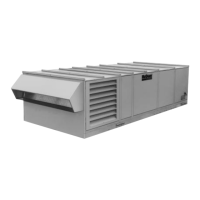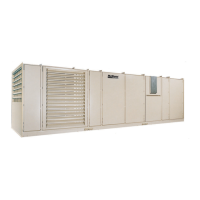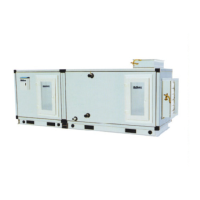IM-738 Page 77
Check, Test, and Start Procedures
All units are completely run tested at the factory to promote
proper operation in the field. Nevertheless, the following
check, test, and start procedures must be performed to properly
start the unit. To obtain full warranty coverage, the check, test,
and start form supplied with the unit must be completed,
signed, and returned to McQuay International.
A representative of the owner or the operator of the equipment
should be present during start-up to receive instructions in the
operation, care, and maintenance of the unit.
Before Start-up
1. Verify that the unit is completely and properly installed
with ductwork connected. Verify that all construction
debris is removed, and that the filters are clean.
2. Verify that all electrical work is complete and properly ter-
minated. Verify that all electrical connections in the unit
control panel and compressor terminal box are tight, and
that the proper voltage is connected. Verify all nameplate
electrical data is compatible with the power supply. Verify
the phase voltage imbalance is no greater than 10 %.
3. Verify that gas piping is complete and leak tight. Verify
that the shutoff cock is installed ahead of the furnace, and
that all air has been bled from the gas lines.
4. Manually rotate all fans and verify that they rotate freely.
Verify that the belts are tight and the sheaves are aligned.
5. Verify that all setscrews and fasteners on the fan assem-
blies are still tight. Do this by reading and following the
instructions in "Setscrews" which is in the "Maintenance"
section of this manual.
6. Verify that the evaporator condensate drain is trapped, and
that the drain pan is level.
7. If unit is curb mounted, verify that the curb is properly
flashed to prevent water leakage.
8. Before attempting to operate the unit, review the control layout
description to become familiar with the control locations.
Review the equipment and service literature, the sequences of
operation, and the wiring diagrams to become familiar with the
functions and purposes of the controls and devices.
Determine which optional controls are included with the unit.
9. Before closing the power disconnect switch, open the fol-
lowing unit control circuit switches:
a. Main Control Panel
• Turn system switch S1 to "off."
• Electric heat units: turn switch HS1 to "off."
b. Compressor Compartment
• Turn compressor control circuit switches
CS1, CS2 to "off."
• Turn liquid line solenoid valve switches
PS1, PS2, PS3 to "off."
c. Furnace Control Compartment
• Turn furnace switch S3 to "off."
d. Main Control Panel Switch
S7.
10.If the VAV or CAV-DTC unit does not have an optional
zone temperature sensor (ZNT1) connected to it, change
the entry under keypad menu item 28C ("Space Sensor=")
from "Yes" to "No."
11.If desired, all MicroTech II internal control timers can be
reduced to 20 seconds by changing the entry under key-
pad menu item 28B ("Timers=") from "Normal" to
"Fast." This will reduce the delays associated with nor-
mal control action for 15 minutes or until the entry is
changed back to "Normal."
Power-up
1. Close the unit disconnect switch. With the control system
switch S1 in the "off" position, power should only be
available to the compressor crankcase heaters.
2. Turn the S1 switch to "on." Power should now be supplied to
the MicroTech II controller, and the LEDs on MCB1 (red,
green, and amber) should follow the normal startup sequence
(refer to the "Component Data" section of IM 483).
3. Turn Switch S7 to ON or AUTO.
Fan Start-up
1. Verify all duct isolation dampers are open. Unit mounted
isolation dampers may be mounted in the supply or
return sections.
2. Place the unit into the "0cc-Fan Only" mode through key-
pad menu 11 ("Control Mode"). The controller should
enter the "Startup Initial" operating state. After the Startup
Initial timer has expired (3 to 4 minutes), the fans should
start. Observe the fan rotation and, if it is backwards, dis-
connect power and reverse two legs of the power supply.
If a fan does not run, do the following:
a.Check the control circuit fuse Fl.
b.Verify that the overloads have not tripped.
c.Check the fan motor power fuses.
d.Verify that the Remote Monitor Panel wiring
(if any) is correct.
e.Trace the circuits.
WARNING
Electric shock and moving machinery hazard. Can
cause severe equipment damage, personal injury, or
death.
Disconnect electrical power before servicing this
equipment.
All start-up and service work must be performed by
qualified technicians who are familiar with the hazards of
working on this type of equipment.
Do not attempt to operate or service this equipment
without first reading and understanding this manual, the
"MicroTech II Applied Rooftop Unit Controller" manual
(Bulletin No. IM 483), and the applicable operation
manual (Bulletin No. OM 108, OM 109, or OM 110).
Provide that the frame of the equipment is bonded to the
building electrical ground by use of the grounding
terminal or by other acceptable means.

